International Marketing: A Comparison between Chinese and New Zealand Market
VerifiedAdded on 2023/06/08
|13
|3970
|76
AI Summary
This study highlights the comparison between Chinese and New Zealand market by highlighting the international marketing practices. The major cultural differences, target market and segmentation, identification of issues and measurable recommendations have been discussed.
Contribute Materials
Your contribution can guide someone’s learning journey. Share your
documents today.
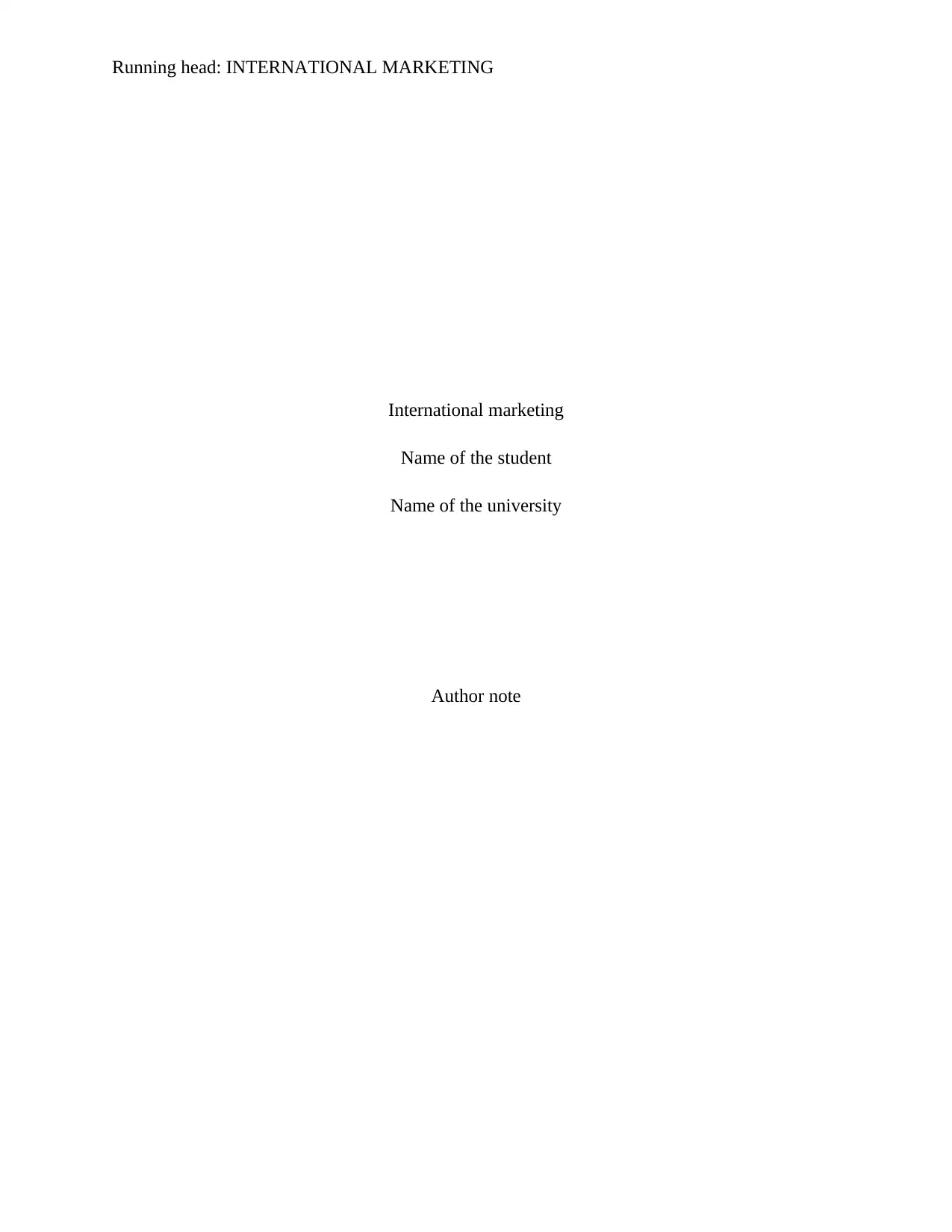
Running head: INTERNATIONAL MARKETING
International marketing
Name of the student
Name of the university
Author note
International marketing
Name of the student
Name of the university
Author note
Secure Best Marks with AI Grader
Need help grading? Try our AI Grader for instant feedback on your assignments.
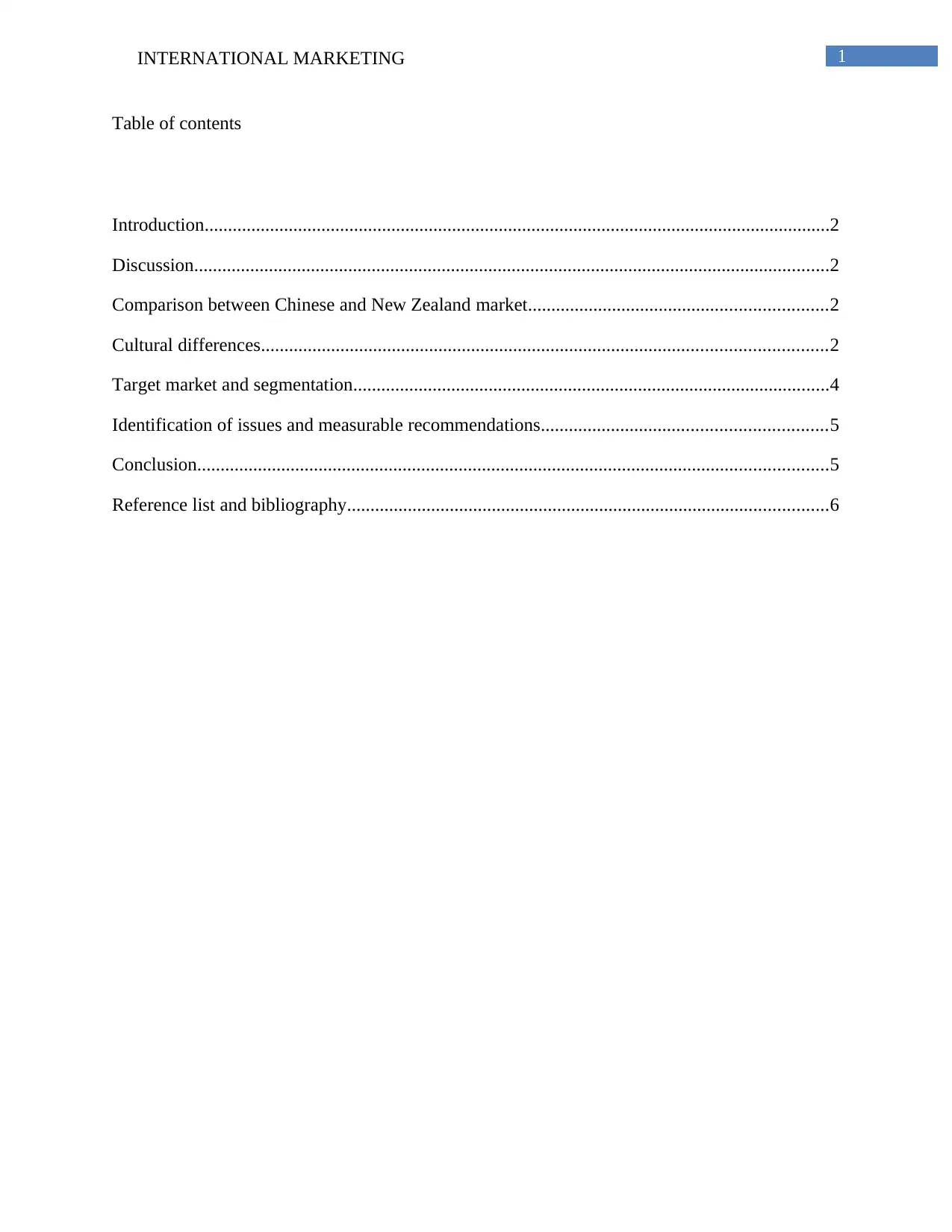
1INTERNATIONAL MARKETING
Table of contents
Introduction......................................................................................................................................2
Discussion........................................................................................................................................2
Comparison between Chinese and New Zealand market................................................................2
Cultural differences.........................................................................................................................2
Target market and segmentation......................................................................................................4
Identification of issues and measurable recommendations.............................................................5
Conclusion.......................................................................................................................................5
Reference list and bibliography.......................................................................................................6
Table of contents
Introduction......................................................................................................................................2
Discussion........................................................................................................................................2
Comparison between Chinese and New Zealand market................................................................2
Cultural differences.........................................................................................................................2
Target market and segmentation......................................................................................................4
Identification of issues and measurable recommendations.............................................................5
Conclusion.......................................................................................................................................5
Reference list and bibliography.......................................................................................................6
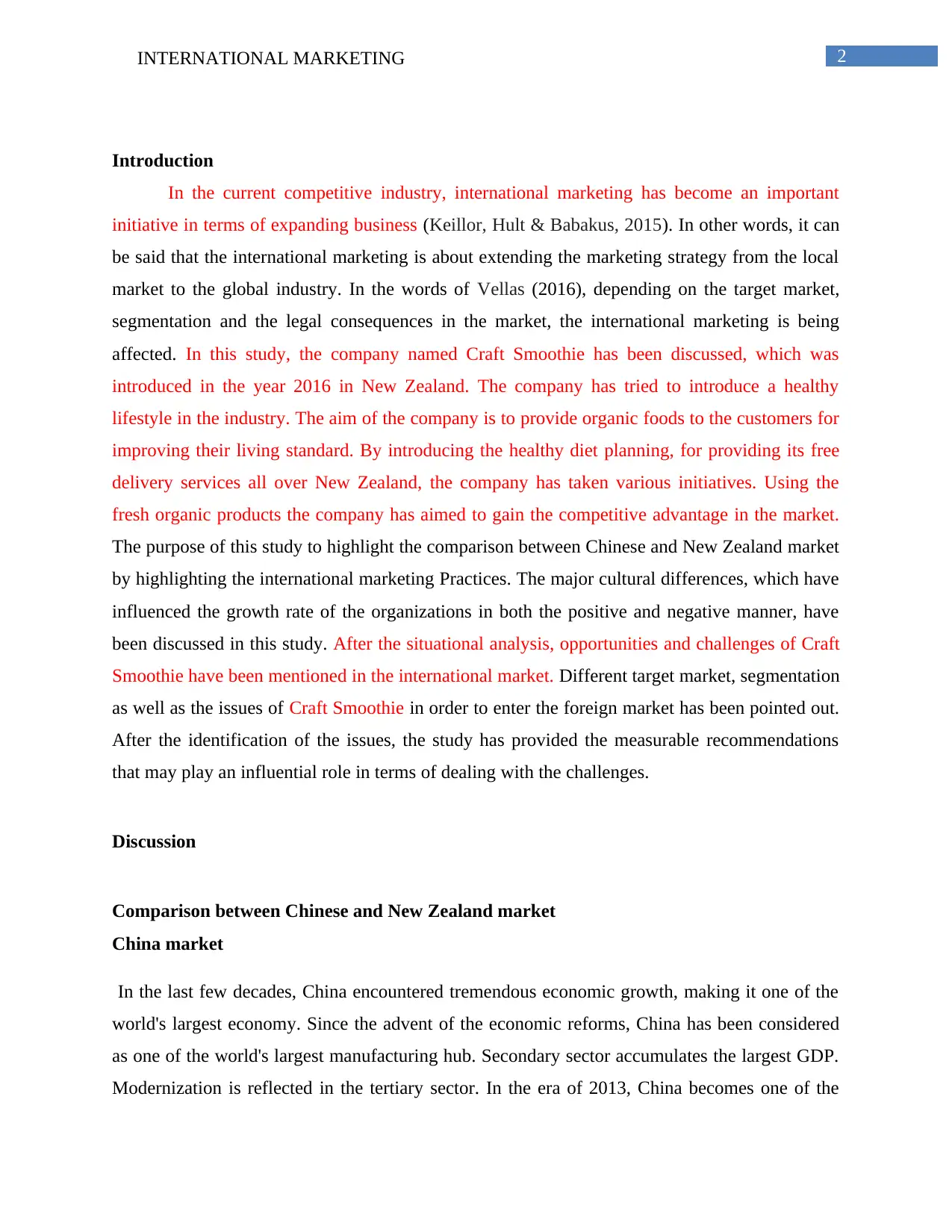
2INTERNATIONAL MARKETING
Introduction
In the current competitive industry, international marketing has become an important
initiative in terms of expanding business (Keillor, Hult & Babakus, 2015). In other words, it can
be said that the international marketing is about extending the marketing strategy from the local
market to the global industry. In the words of Vellas (2016), depending on the target market,
segmentation and the legal consequences in the market, the international marketing is being
affected. In this study, the company named Craft Smoothie has been discussed, which was
introduced in the year 2016 in New Zealand. The company has tried to introduce a healthy
lifestyle in the industry. The aim of the company is to provide organic foods to the customers for
improving their living standard. By introducing the healthy diet planning, for providing its free
delivery services all over New Zealand, the company has taken various initiatives. Using the
fresh organic products the company has aimed to gain the competitive advantage in the market.
The purpose of this study to highlight the comparison between Chinese and New Zealand market
by highlighting the international marketing Practices. The major cultural differences, which have
influenced the growth rate of the organizations in both the positive and negative manner, have
been discussed in this study. After the situational analysis, opportunities and challenges of Craft
Smoothie have been mentioned in the international market. Different target market, segmentation
as well as the issues of Craft Smoothie in order to enter the foreign market has been pointed out.
After the identification of the issues, the study has provided the measurable recommendations
that may play an influential role in terms of dealing with the challenges.
Discussion
Comparison between Chinese and New Zealand market
China market
In the last few decades, China encountered tremendous economic growth, making it one of the
world's largest economy. Since the advent of the economic reforms, China has been considered
as one of the world's largest manufacturing hub. Secondary sector accumulates the largest GDP.
Modernization is reflected in the tertiary sector. In the era of 2013, China becomes one of the
Introduction
In the current competitive industry, international marketing has become an important
initiative in terms of expanding business (Keillor, Hult & Babakus, 2015). In other words, it can
be said that the international marketing is about extending the marketing strategy from the local
market to the global industry. In the words of Vellas (2016), depending on the target market,
segmentation and the legal consequences in the market, the international marketing is being
affected. In this study, the company named Craft Smoothie has been discussed, which was
introduced in the year 2016 in New Zealand. The company has tried to introduce a healthy
lifestyle in the industry. The aim of the company is to provide organic foods to the customers for
improving their living standard. By introducing the healthy diet planning, for providing its free
delivery services all over New Zealand, the company has taken various initiatives. Using the
fresh organic products the company has aimed to gain the competitive advantage in the market.
The purpose of this study to highlight the comparison between Chinese and New Zealand market
by highlighting the international marketing Practices. The major cultural differences, which have
influenced the growth rate of the organizations in both the positive and negative manner, have
been discussed in this study. After the situational analysis, opportunities and challenges of Craft
Smoothie have been mentioned in the international market. Different target market, segmentation
as well as the issues of Craft Smoothie in order to enter the foreign market has been pointed out.
After the identification of the issues, the study has provided the measurable recommendations
that may play an influential role in terms of dealing with the challenges.
Discussion
Comparison between Chinese and New Zealand market
China market
In the last few decades, China encountered tremendous economic growth, making it one of the
world's largest economy. Since the advent of the economic reforms, China has been considered
as one of the world's largest manufacturing hub. Secondary sector accumulates the largest GDP.
Modernization is reflected in the tertiary sector. In the era of 2013, China becomes one of the

3INTERNATIONAL MARKETING
largest countries in terms of GDP with a share of 46.1% (Gov.cn, 2018). The secondary sector
accounts for 45% of the total output. Primary sector has collapsed noticeable with the advent of
globalization.
According to (Nzherald.co.nz, 2018), New Zealand is considered the virtual economic
trade prisoner of China. The trade policies reflect activity, which increases the dependence on the
single commodity. This has increased the anxieties towards maximizing the trade advantage.
China encountered global economic crisis more than the other countries. In November 2008, the
State Council announced CNY of 4 trillion in terms of dealing with the crisis. Financial stability
was achieved with 9% growth in the GDP (Gov.cn, 2018). Along with this, a low level of
inflation was recorded. However, the fiscal position was strong. The policies implemented
during the crisis possessed flexibility in exacerbating the macroeconomic imbalances
(Papadopoulos & Heslop, 2014). The leadership of President Xi Jinping and Premier Li
Keqiang, promoted a balanced economic model, helping in the achievement of economic
growth.
Since the era of 1993, China has encountered trade surpluses. In 2013, China surpassed the
United States when the total trade multiplied by 100 to USD 4.2 trillion. Massive investment
programs made the country a manufacturing hub. Alliance with the World Trade Organization
triggered the trade growth. Bilateral and multilateral trade agreements opened new markets for
China. Mention can be made of the Closer Economic Partnership Agreement with Hong Kong
and Macau (Gov.cn, 2018). Electronics and machinery constitute about 55% of the total exports.
In the case of garments, the export is 13%, construction materials and equipment accounts for
7%. 40% of the exports are made to Asia. North America and Europe have a share of 23 and
24% of the exports. Africa and South America constitute 8% of the total exports (De Mooij,
2015).
New Zealand
New Zealand market operates on free-market principles with a mixed economy. The country
possesses sizeable manufacturing and service sectors. The staple activity is agriculture. Export
for the goods and services accounts for one third of the total GDP. The average GDP growth per
capita has encountered a noticeable decline in the last decades than the other OECD countries.
largest countries in terms of GDP with a share of 46.1% (Gov.cn, 2018). The secondary sector
accounts for 45% of the total output. Primary sector has collapsed noticeable with the advent of
globalization.
According to (Nzherald.co.nz, 2018), New Zealand is considered the virtual economic
trade prisoner of China. The trade policies reflect activity, which increases the dependence on the
single commodity. This has increased the anxieties towards maximizing the trade advantage.
China encountered global economic crisis more than the other countries. In November 2008, the
State Council announced CNY of 4 trillion in terms of dealing with the crisis. Financial stability
was achieved with 9% growth in the GDP (Gov.cn, 2018). Along with this, a low level of
inflation was recorded. However, the fiscal position was strong. The policies implemented
during the crisis possessed flexibility in exacerbating the macroeconomic imbalances
(Papadopoulos & Heslop, 2014). The leadership of President Xi Jinping and Premier Li
Keqiang, promoted a balanced economic model, helping in the achievement of economic
growth.
Since the era of 1993, China has encountered trade surpluses. In 2013, China surpassed the
United States when the total trade multiplied by 100 to USD 4.2 trillion. Massive investment
programs made the country a manufacturing hub. Alliance with the World Trade Organization
triggered the trade growth. Bilateral and multilateral trade agreements opened new markets for
China. Mention can be made of the Closer Economic Partnership Agreement with Hong Kong
and Macau (Gov.cn, 2018). Electronics and machinery constitute about 55% of the total exports.
In the case of garments, the export is 13%, construction materials and equipment accounts for
7%. 40% of the exports are made to Asia. North America and Europe have a share of 23 and
24% of the exports. Africa and South America constitute 8% of the total exports (De Mooij,
2015).
New Zealand
New Zealand market operates on free-market principles with a mixed economy. The country
possesses sizeable manufacturing and service sectors. The staple activity is agriculture. Export
for the goods and services accounts for one third of the total GDP. The average GDP growth per
capita has encountered a noticeable decline in the last decades than the other OECD countries.
Secure Best Marks with AI Grader
Need help grading? Try our AI Grader for instant feedback on your assignments.
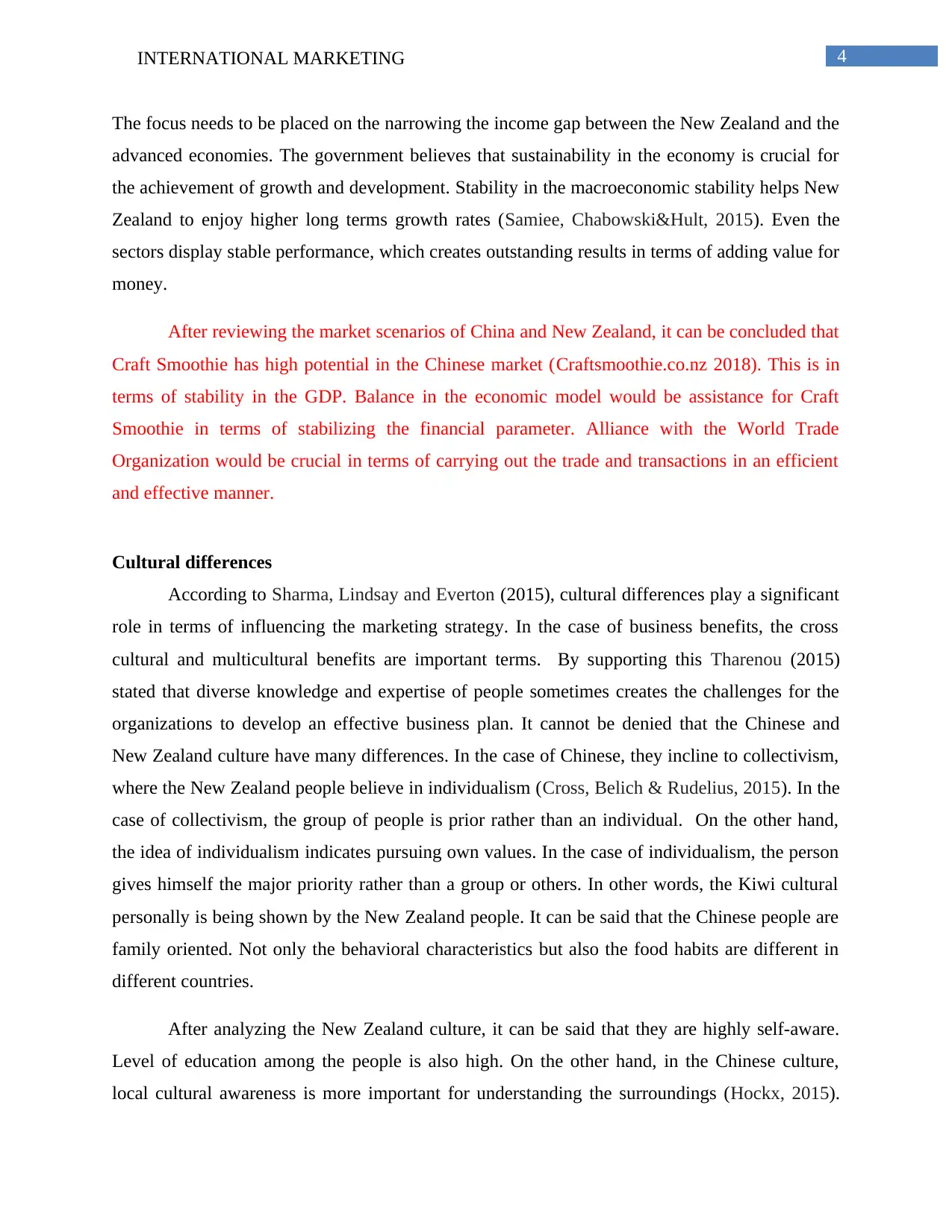
4INTERNATIONAL MARKETING
The focus needs to be placed on the narrowing the income gap between the New Zealand and the
advanced economies. The government believes that sustainability in the economy is crucial for
the achievement of growth and development. Stability in the macroeconomic stability helps New
Zealand to enjoy higher long terms growth rates (Samiee, Chabowski&Hult, 2015). Even the
sectors display stable performance, which creates outstanding results in terms of adding value for
money.
After reviewing the market scenarios of China and New Zealand, it can be concluded that
Craft Smoothie has high potential in the Chinese market (Craftsmoothie.co.nz 2018). This is in
terms of stability in the GDP. Balance in the economic model would be assistance for Craft
Smoothie in terms of stabilizing the financial parameter. Alliance with the World Trade
Organization would be crucial in terms of carrying out the trade and transactions in an efficient
and effective manner.
Cultural differences
According to Sharma, Lindsay and Everton (2015), cultural differences play a significant
role in terms of influencing the marketing strategy. In the case of business benefits, the cross
cultural and multicultural benefits are important terms. By supporting this Tharenou (2015)
stated that diverse knowledge and expertise of people sometimes creates the challenges for the
organizations to develop an effective business plan. It cannot be denied that the Chinese and
New Zealand culture have many differences. In the case of Chinese, they incline to collectivism,
where the New Zealand people believe in individualism (Cross, Belich & Rudelius, 2015). In the
case of collectivism, the group of people is prior rather than an individual. On the other hand,
the idea of individualism indicates pursuing own values. In the case of individualism, the person
gives himself the major priority rather than a group or others. In other words, the Kiwi cultural
personally is being shown by the New Zealand people. It can be said that the Chinese people are
family oriented. Not only the behavioral characteristics but also the food habits are different in
different countries.
After analyzing the New Zealand culture, it can be said that they are highly self-aware.
Level of education among the people is also high. On the other hand, in the Chinese culture,
local cultural awareness is more important for understanding the surroundings (Hockx, 2015).
The focus needs to be placed on the narrowing the income gap between the New Zealand and the
advanced economies. The government believes that sustainability in the economy is crucial for
the achievement of growth and development. Stability in the macroeconomic stability helps New
Zealand to enjoy higher long terms growth rates (Samiee, Chabowski&Hult, 2015). Even the
sectors display stable performance, which creates outstanding results in terms of adding value for
money.
After reviewing the market scenarios of China and New Zealand, it can be concluded that
Craft Smoothie has high potential in the Chinese market (Craftsmoothie.co.nz 2018). This is in
terms of stability in the GDP. Balance in the economic model would be assistance for Craft
Smoothie in terms of stabilizing the financial parameter. Alliance with the World Trade
Organization would be crucial in terms of carrying out the trade and transactions in an efficient
and effective manner.
Cultural differences
According to Sharma, Lindsay and Everton (2015), cultural differences play a significant
role in terms of influencing the marketing strategy. In the case of business benefits, the cross
cultural and multicultural benefits are important terms. By supporting this Tharenou (2015)
stated that diverse knowledge and expertise of people sometimes creates the challenges for the
organizations to develop an effective business plan. It cannot be denied that the Chinese and
New Zealand culture have many differences. In the case of Chinese, they incline to collectivism,
where the New Zealand people believe in individualism (Cross, Belich & Rudelius, 2015). In the
case of collectivism, the group of people is prior rather than an individual. On the other hand,
the idea of individualism indicates pursuing own values. In the case of individualism, the person
gives himself the major priority rather than a group or others. In other words, the Kiwi cultural
personally is being shown by the New Zealand people. It can be said that the Chinese people are
family oriented. Not only the behavioral characteristics but also the food habits are different in
different countries.
After analyzing the New Zealand culture, it can be said that they are highly self-aware.
Level of education among the people is also high. On the other hand, in the Chinese culture,
local cultural awareness is more important for understanding the surroundings (Hockx, 2015).

5INTERNATIONAL MARKETING
Due to such cultural variety, the market planning practices are being affected. In this situation, if
the New Zealand business organization wants to enter the Chinese market, it needs to focus on
adopting the concept of collectivism. Without such initiatives, it will be harder to interact with
the target market. As stated by Hamamura and Xu (2015), after analyzing the behavioral changes
of the New Zealand people, it can be said that they are sometimes rude and aggressive towards
strangers. While convincing the customers in different countries, the executives will be
impatience that can impact on its development procedure. In most of the cases, the professional
people do not meet with anyone without appointments. By arguing this Zhong (2018) said in
order to establish its business in the foreign market, the New Zealand organizations should be
more interactive and polite towards strangers.
It is also true that New Zealand people are highly brand fascinated and fond of foreign
products (Sun, Ryan & Pan, 2015). As the New Zealand people are fond of technology,
therefore, in some cases where the new product of technological equipment is being introduced
in the market, they easily get influenced. On the other hand, in the case of Chinese, they are very
loyal. In case of this, if they trust a brand or company, it is hard to change their preferences.
However, in the case of the New Zealand market, it is hard to get the loyal customers are they
are very demanding (Kumar, 2015). Therefore, comparing both the markets, it has been
identified that the Chinese market will be easier for the New Zealand organization namely Craft
Smoothie if the marketing plan will be developed by respecting the different tradition and
culture. As the Chinese people give importance to their traditional values, therefore, it is hard for
them to accept the foreign products. Another way, it can be said that the Chinese people are
being influenced by their family and friends easily. In such cases, in order to develop a business
plan, it is hard for Craft Smoothie to influence them. Hence, the business promotions should be
developed in a proper manner so that the emotions of the customers will not get hurt.
Target market and segmentation
Identification of the target market is very important in order to do a successful business
(Armstrong et al., 2014). By identifying the target market, the company will be able to use its
resource in an effective manner (Phillips, 2016). It is beneficial in terms of pointing out the needs
of individuals. Hence, it can be said that the target market is being considered as the essential
Due to such cultural variety, the market planning practices are being affected. In this situation, if
the New Zealand business organization wants to enter the Chinese market, it needs to focus on
adopting the concept of collectivism. Without such initiatives, it will be harder to interact with
the target market. As stated by Hamamura and Xu (2015), after analyzing the behavioral changes
of the New Zealand people, it can be said that they are sometimes rude and aggressive towards
strangers. While convincing the customers in different countries, the executives will be
impatience that can impact on its development procedure. In most of the cases, the professional
people do not meet with anyone without appointments. By arguing this Zhong (2018) said in
order to establish its business in the foreign market, the New Zealand organizations should be
more interactive and polite towards strangers.
It is also true that New Zealand people are highly brand fascinated and fond of foreign
products (Sun, Ryan & Pan, 2015). As the New Zealand people are fond of technology,
therefore, in some cases where the new product of technological equipment is being introduced
in the market, they easily get influenced. On the other hand, in the case of Chinese, they are very
loyal. In case of this, if they trust a brand or company, it is hard to change their preferences.
However, in the case of the New Zealand market, it is hard to get the loyal customers are they
are very demanding (Kumar, 2015). Therefore, comparing both the markets, it has been
identified that the Chinese market will be easier for the New Zealand organization namely Craft
Smoothie if the marketing plan will be developed by respecting the different tradition and
culture. As the Chinese people give importance to their traditional values, therefore, it is hard for
them to accept the foreign products. Another way, it can be said that the Chinese people are
being influenced by their family and friends easily. In such cases, in order to develop a business
plan, it is hard for Craft Smoothie to influence them. Hence, the business promotions should be
developed in a proper manner so that the emotions of the customers will not get hurt.
Target market and segmentation
Identification of the target market is very important in order to do a successful business
(Armstrong et al., 2014). By identifying the target market, the company will be able to use its
resource in an effective manner (Phillips, 2016). It is beneficial in terms of pointing out the needs
of individuals. Hence, it can be said that the target market is being considered as the essential
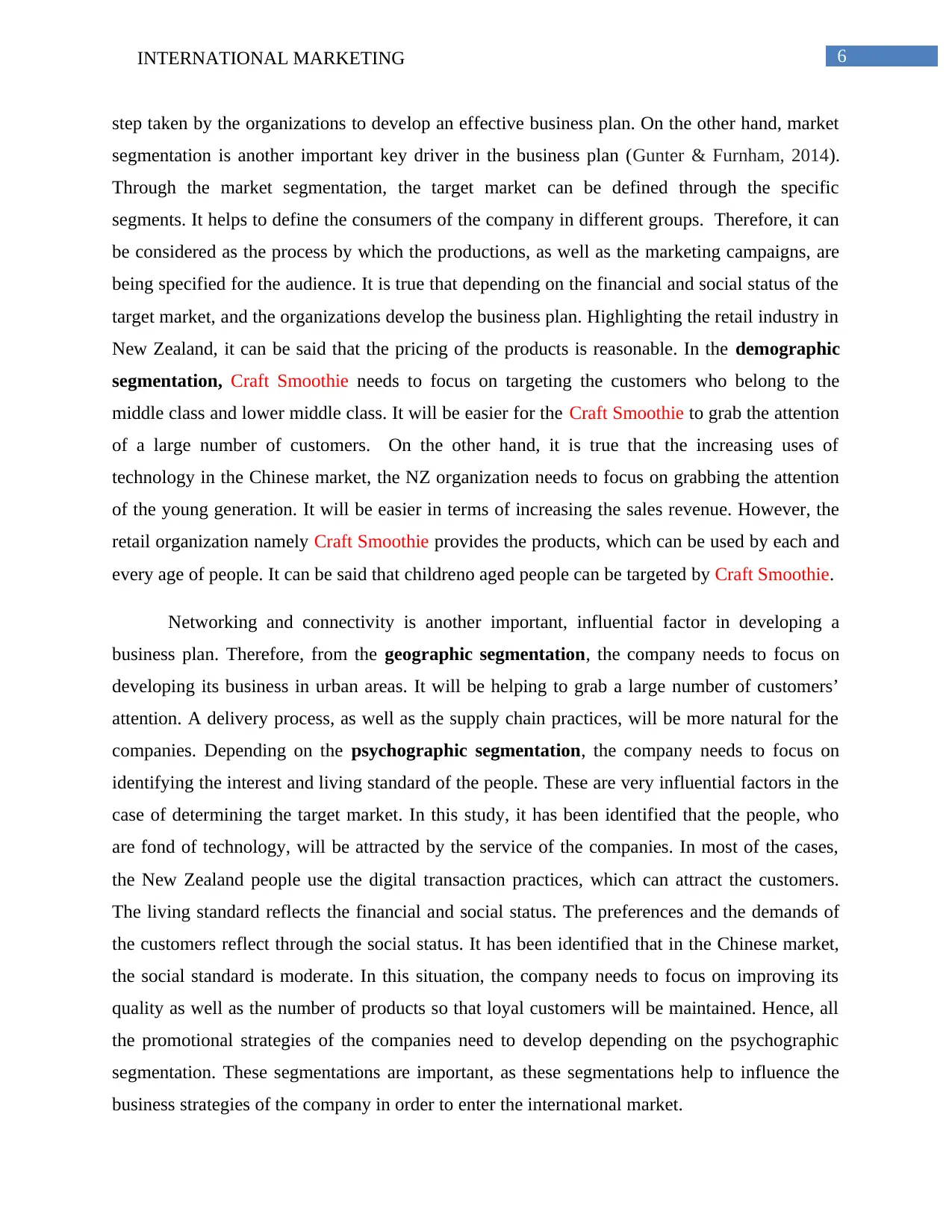
6INTERNATIONAL MARKETING
step taken by the organizations to develop an effective business plan. On the other hand, market
segmentation is another important key driver in the business plan (Gunter & Furnham, 2014).
Through the market segmentation, the target market can be defined through the specific
segments. It helps to define the consumers of the company in different groups. Therefore, it can
be considered as the process by which the productions, as well as the marketing campaigns, are
being specified for the audience. It is true that depending on the financial and social status of the
target market, and the organizations develop the business plan. Highlighting the retail industry in
New Zealand, it can be said that the pricing of the products is reasonable. In the demographic
segmentation, Craft Smoothie needs to focus on targeting the customers who belong to the
middle class and lower middle class. It will be easier for the Craft Smoothie to grab the attention
of a large number of customers. On the other hand, it is true that the increasing uses of
technology in the Chinese market, the NZ organization needs to focus on grabbing the attention
of the young generation. It will be easier in terms of increasing the sales revenue. However, the
retail organization namely Craft Smoothie provides the products, which can be used by each and
every age of people. It can be said that childreno aged people can be targeted by Craft Smoothie.
Networking and connectivity is another important, influential factor in developing a
business plan. Therefore, from the geographic segmentation, the company needs to focus on
developing its business in urban areas. It will be helping to grab a large number of customers’
attention. A delivery process, as well as the supply chain practices, will be more natural for the
companies. Depending on the psychographic segmentation, the company needs to focus on
identifying the interest and living standard of the people. These are very influential factors in the
case of determining the target market. In this study, it has been identified that the people, who
are fond of technology, will be attracted by the service of the companies. In most of the cases,
the New Zealand people use the digital transaction practices, which can attract the customers.
The living standard reflects the financial and social status. The preferences and the demands of
the customers reflect through the social status. It has been identified that in the Chinese market,
the social standard is moderate. In this situation, the company needs to focus on improving its
quality as well as the number of products so that loyal customers will be maintained. Hence, all
the promotional strategies of the companies need to develop depending on the psychographic
segmentation. These segmentations are important, as these segmentations help to influence the
business strategies of the company in order to enter the international market.
step taken by the organizations to develop an effective business plan. On the other hand, market
segmentation is another important key driver in the business plan (Gunter & Furnham, 2014).
Through the market segmentation, the target market can be defined through the specific
segments. It helps to define the consumers of the company in different groups. Therefore, it can
be considered as the process by which the productions, as well as the marketing campaigns, are
being specified for the audience. It is true that depending on the financial and social status of the
target market, and the organizations develop the business plan. Highlighting the retail industry in
New Zealand, it can be said that the pricing of the products is reasonable. In the demographic
segmentation, Craft Smoothie needs to focus on targeting the customers who belong to the
middle class and lower middle class. It will be easier for the Craft Smoothie to grab the attention
of a large number of customers. On the other hand, it is true that the increasing uses of
technology in the Chinese market, the NZ organization needs to focus on grabbing the attention
of the young generation. It will be easier in terms of increasing the sales revenue. However, the
retail organization namely Craft Smoothie provides the products, which can be used by each and
every age of people. It can be said that childreno aged people can be targeted by Craft Smoothie.
Networking and connectivity is another important, influential factor in developing a
business plan. Therefore, from the geographic segmentation, the company needs to focus on
developing its business in urban areas. It will be helping to grab a large number of customers’
attention. A delivery process, as well as the supply chain practices, will be more natural for the
companies. Depending on the psychographic segmentation, the company needs to focus on
identifying the interest and living standard of the people. These are very influential factors in the
case of determining the target market. In this study, it has been identified that the people, who
are fond of technology, will be attracted by the service of the companies. In most of the cases,
the New Zealand people use the digital transaction practices, which can attract the customers.
The living standard reflects the financial and social status. The preferences and the demands of
the customers reflect through the social status. It has been identified that in the Chinese market,
the social standard is moderate. In this situation, the company needs to focus on improving its
quality as well as the number of products so that loyal customers will be maintained. Hence, all
the promotional strategies of the companies need to develop depending on the psychographic
segmentation. These segmentations are important, as these segmentations help to influence the
business strategies of the company in order to enter the international market.
Paraphrase This Document
Need a fresh take? Get an instant paraphrase of this document with our AI Paraphraser
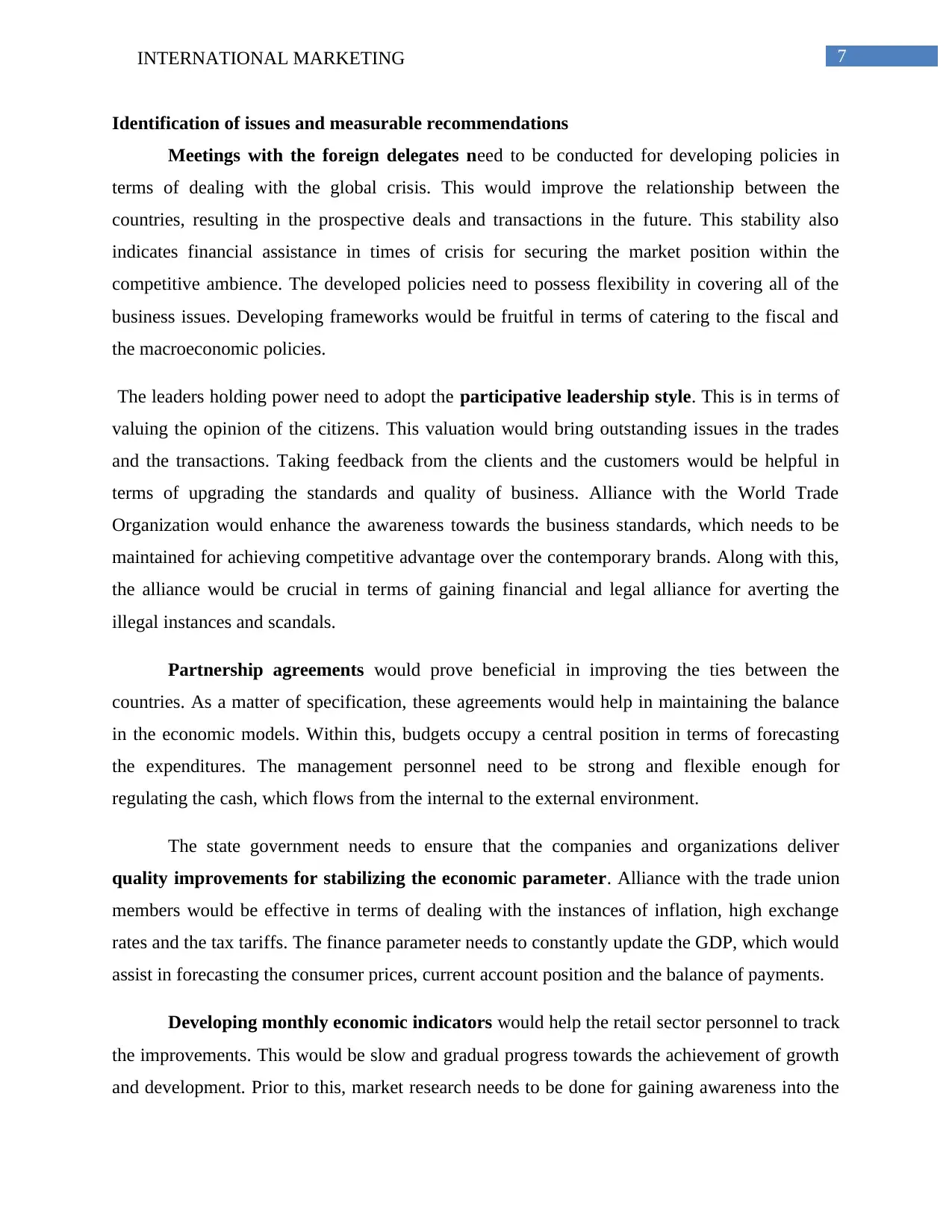
7INTERNATIONAL MARKETING
Identification of issues and measurable recommendations
Meetings with the foreign delegates need to be conducted for developing policies in
terms of dealing with the global crisis. This would improve the relationship between the
countries, resulting in the prospective deals and transactions in the future. This stability also
indicates financial assistance in times of crisis for securing the market position within the
competitive ambience. The developed policies need to possess flexibility in covering all of the
business issues. Developing frameworks would be fruitful in terms of catering to the fiscal and
the macroeconomic policies.
The leaders holding power need to adopt the participative leadership style. This is in terms of
valuing the opinion of the citizens. This valuation would bring outstanding issues in the trades
and the transactions. Taking feedback from the clients and the customers would be helpful in
terms of upgrading the standards and quality of business. Alliance with the World Trade
Organization would enhance the awareness towards the business standards, which needs to be
maintained for achieving competitive advantage over the contemporary brands. Along with this,
the alliance would be crucial in terms of gaining financial and legal alliance for averting the
illegal instances and scandals.
Partnership agreements would prove beneficial in improving the ties between the
countries. As a matter of specification, these agreements would help in maintaining the balance
in the economic models. Within this, budgets occupy a central position in terms of forecasting
the expenditures. The management personnel need to be strong and flexible enough for
regulating the cash, which flows from the internal to the external environment.
The state government needs to ensure that the companies and organizations deliver
quality improvements for stabilizing the economic parameter. Alliance with the trade union
members would be effective in terms of dealing with the instances of inflation, high exchange
rates and the tax tariffs. The finance parameter needs to constantly update the GDP, which would
assist in forecasting the consumer prices, current account position and the balance of payments.
Developing monthly economic indicators would help the retail sector personnel to track
the improvements. This would be slow and gradual progress towards the achievement of growth
and development. Prior to this, market research needs to be done for gaining awareness into the
Identification of issues and measurable recommendations
Meetings with the foreign delegates need to be conducted for developing policies in
terms of dealing with the global crisis. This would improve the relationship between the
countries, resulting in the prospective deals and transactions in the future. This stability also
indicates financial assistance in times of crisis for securing the market position within the
competitive ambience. The developed policies need to possess flexibility in covering all of the
business issues. Developing frameworks would be fruitful in terms of catering to the fiscal and
the macroeconomic policies.
The leaders holding power need to adopt the participative leadership style. This is in terms of
valuing the opinion of the citizens. This valuation would bring outstanding issues in the trades
and the transactions. Taking feedback from the clients and the customers would be helpful in
terms of upgrading the standards and quality of business. Alliance with the World Trade
Organization would enhance the awareness towards the business standards, which needs to be
maintained for achieving competitive advantage over the contemporary brands. Along with this,
the alliance would be crucial in terms of gaining financial and legal alliance for averting the
illegal instances and scandals.
Partnership agreements would prove beneficial in improving the ties between the
countries. As a matter of specification, these agreements would help in maintaining the balance
in the economic models. Within this, budgets occupy a central position in terms of forecasting
the expenditures. The management personnel need to be strong and flexible enough for
regulating the cash, which flows from the internal to the external environment.
The state government needs to ensure that the companies and organizations deliver
quality improvements for stabilizing the economic parameter. Alliance with the trade union
members would be effective in terms of dealing with the instances of inflation, high exchange
rates and the tax tariffs. The finance parameter needs to constantly update the GDP, which would
assist in forecasting the consumer prices, current account position and the balance of payments.
Developing monthly economic indicators would help the retail sector personnel to track
the improvements. This would be slow and gradual progress towards the achievement of growth
and development. Prior to this, market research needs to be done for gaining awareness into the
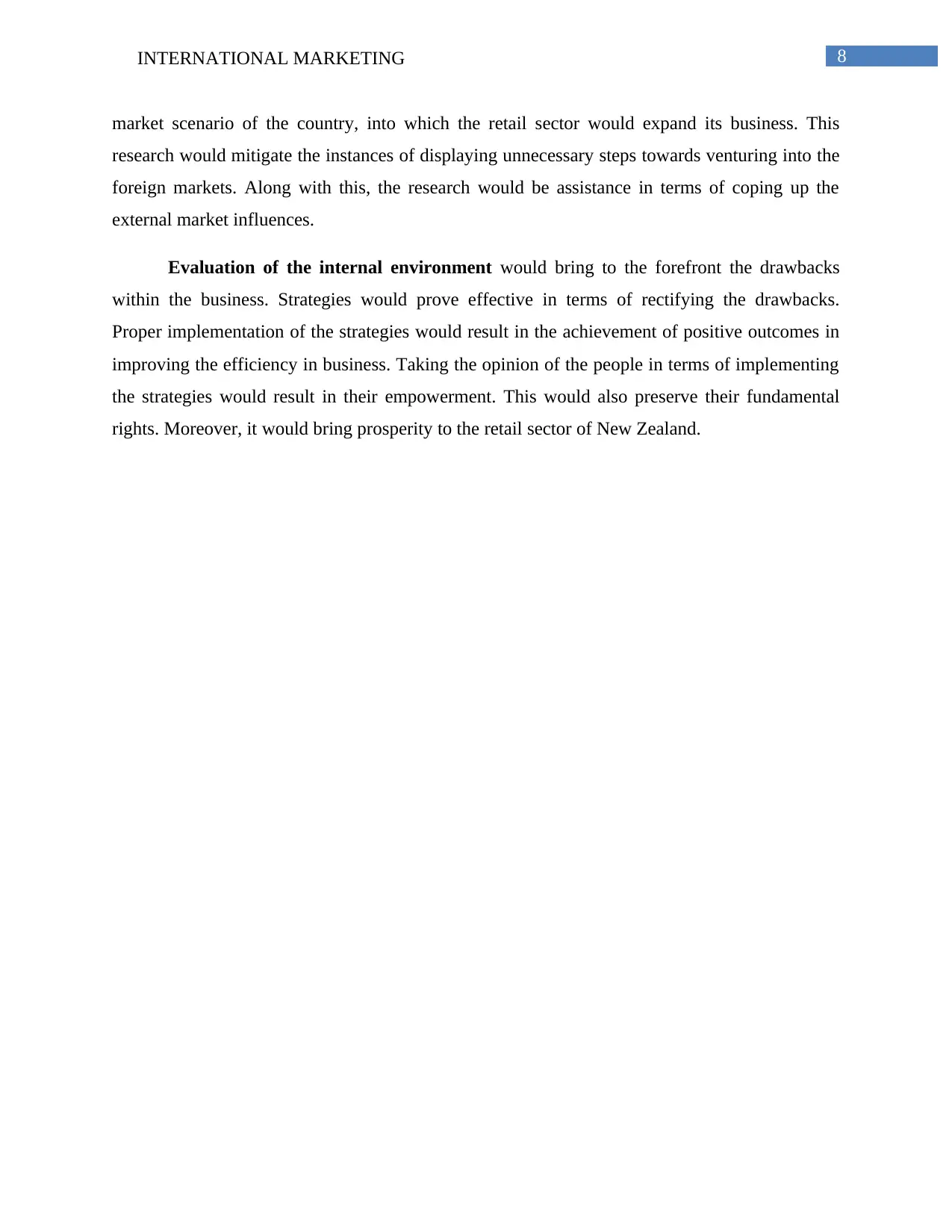
8INTERNATIONAL MARKETING
market scenario of the country, into which the retail sector would expand its business. This
research would mitigate the instances of displaying unnecessary steps towards venturing into the
foreign markets. Along with this, the research would be assistance in terms of coping up the
external market influences.
Evaluation of the internal environment would bring to the forefront the drawbacks
within the business. Strategies would prove effective in terms of rectifying the drawbacks.
Proper implementation of the strategies would result in the achievement of positive outcomes in
improving the efficiency in business. Taking the opinion of the people in terms of implementing
the strategies would result in their empowerment. This would also preserve their fundamental
rights. Moreover, it would bring prosperity to the retail sector of New Zealand.
market scenario of the country, into which the retail sector would expand its business. This
research would mitigate the instances of displaying unnecessary steps towards venturing into the
foreign markets. Along with this, the research would be assistance in terms of coping up the
external market influences.
Evaluation of the internal environment would bring to the forefront the drawbacks
within the business. Strategies would prove effective in terms of rectifying the drawbacks.
Proper implementation of the strategies would result in the achievement of positive outcomes in
improving the efficiency in business. Taking the opinion of the people in terms of implementing
the strategies would result in their empowerment. This would also preserve their fundamental
rights. Moreover, it would bring prosperity to the retail sector of New Zealand.

9INTERNATIONAL MARKETING
Conclusion
In this study, it can be concluded that entering the foreign market is not easy.
Highlighting the comparison between New Zealand and China, it has been mentioned in this
study that it is tough to enter in the foreign market as the demands and needs of the customers
are totally different. On the other hand, cultural and legal barriers in the international market
create the challenges for the organizations for entering the international market. While
comparing the Chinese and New Zealand culture, it has been highlighted in the study that
grabbing the attention of the customers is truly difficult for their various behavioral
characteristics. In this study, it has been identified that after the introduction of financial loss,
CNY has introduced the contribution of 4 trillion. In this situation, the business development will
become easier for Craft Smoothie. After analyzing the issues regarding partnership agreements,
rules and regulations and lack of effective leadership styles, here the study has provided above
measurable solutions. It can be said that, if the leadership style development practices, as well as
an effective partnership, will be introduced, it can be beneficial for developing the business in
the international market.
Conclusion
In this study, it can be concluded that entering the foreign market is not easy.
Highlighting the comparison between New Zealand and China, it has been mentioned in this
study that it is tough to enter in the foreign market as the demands and needs of the customers
are totally different. On the other hand, cultural and legal barriers in the international market
create the challenges for the organizations for entering the international market. While
comparing the Chinese and New Zealand culture, it has been highlighted in the study that
grabbing the attention of the customers is truly difficult for their various behavioral
characteristics. In this study, it has been identified that after the introduction of financial loss,
CNY has introduced the contribution of 4 trillion. In this situation, the business development will
become easier for Craft Smoothie. After analyzing the issues regarding partnership agreements,
rules and regulations and lack of effective leadership styles, here the study has provided above
measurable solutions. It can be said that, if the leadership style development practices, as well as
an effective partnership, will be introduced, it can be beneficial for developing the business in
the international market.
Secure Best Marks with AI Grader
Need help grading? Try our AI Grader for instant feedback on your assignments.
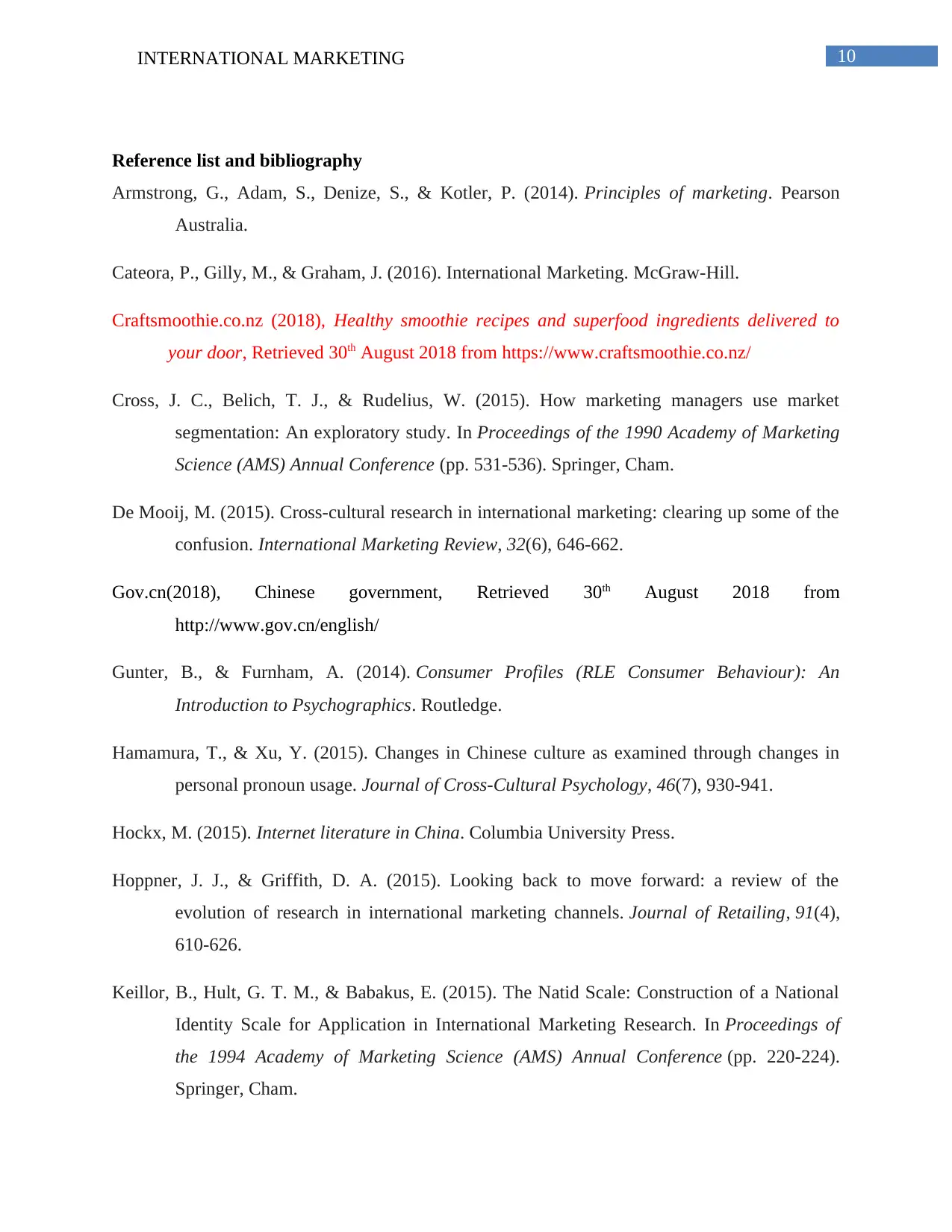
10INTERNATIONAL MARKETING
Reference list and bibliography
Armstrong, G., Adam, S., Denize, S., & Kotler, P. (2014). Principles of marketing. Pearson
Australia.
Cateora, P., Gilly, M., & Graham, J. (2016). International Marketing. McGraw-Hill.
Craftsmoothie.co.nz (2018), Healthy smoothie recipes and superfood ingredients delivered to
your door, Retrieved 30th August 2018 from https://www.craftsmoothie.co.nz/
Cross, J. C., Belich, T. J., & Rudelius, W. (2015). How marketing managers use market
segmentation: An exploratory study. In Proceedings of the 1990 Academy of Marketing
Science (AMS) Annual Conference (pp. 531-536). Springer, Cham.
De Mooij, M. (2015). Cross-cultural research in international marketing: clearing up some of the
confusion. International Marketing Review, 32(6), 646-662.
Gov.cn(2018), Chinese government, Retrieved 30th August 2018 from
http://www.gov.cn/english/
Gunter, B., & Furnham, A. (2014). Consumer Profiles (RLE Consumer Behaviour): An
Introduction to Psychographics. Routledge.
Hamamura, T., & Xu, Y. (2015). Changes in Chinese culture as examined through changes in
personal pronoun usage. Journal of Cross-Cultural Psychology, 46(7), 930-941.
Hockx, M. (2015). Internet literature in China. Columbia University Press.
Hoppner, J. J., & Griffith, D. A. (2015). Looking back to move forward: a review of the
evolution of research in international marketing channels. Journal of Retailing, 91(4),
610-626.
Keillor, B., Hult, G. T. M., & Babakus, E. (2015). The Natid Scale: Construction of a National
Identity Scale for Application in International Marketing Research. In Proceedings of
the 1994 Academy of Marketing Science (AMS) Annual Conference (pp. 220-224).
Springer, Cham.
Reference list and bibliography
Armstrong, G., Adam, S., Denize, S., & Kotler, P. (2014). Principles of marketing. Pearson
Australia.
Cateora, P., Gilly, M., & Graham, J. (2016). International Marketing. McGraw-Hill.
Craftsmoothie.co.nz (2018), Healthy smoothie recipes and superfood ingredients delivered to
your door, Retrieved 30th August 2018 from https://www.craftsmoothie.co.nz/
Cross, J. C., Belich, T. J., & Rudelius, W. (2015). How marketing managers use market
segmentation: An exploratory study. In Proceedings of the 1990 Academy of Marketing
Science (AMS) Annual Conference (pp. 531-536). Springer, Cham.
De Mooij, M. (2015). Cross-cultural research in international marketing: clearing up some of the
confusion. International Marketing Review, 32(6), 646-662.
Gov.cn(2018), Chinese government, Retrieved 30th August 2018 from
http://www.gov.cn/english/
Gunter, B., & Furnham, A. (2014). Consumer Profiles (RLE Consumer Behaviour): An
Introduction to Psychographics. Routledge.
Hamamura, T., & Xu, Y. (2015). Changes in Chinese culture as examined through changes in
personal pronoun usage. Journal of Cross-Cultural Psychology, 46(7), 930-941.
Hockx, M. (2015). Internet literature in China. Columbia University Press.
Hoppner, J. J., & Griffith, D. A. (2015). Looking back to move forward: a review of the
evolution of research in international marketing channels. Journal of Retailing, 91(4),
610-626.
Keillor, B., Hult, G. T. M., & Babakus, E. (2015). The Natid Scale: Construction of a National
Identity Scale for Application in International Marketing Research. In Proceedings of
the 1994 Academy of Marketing Science (AMS) Annual Conference (pp. 220-224).
Springer, Cham.
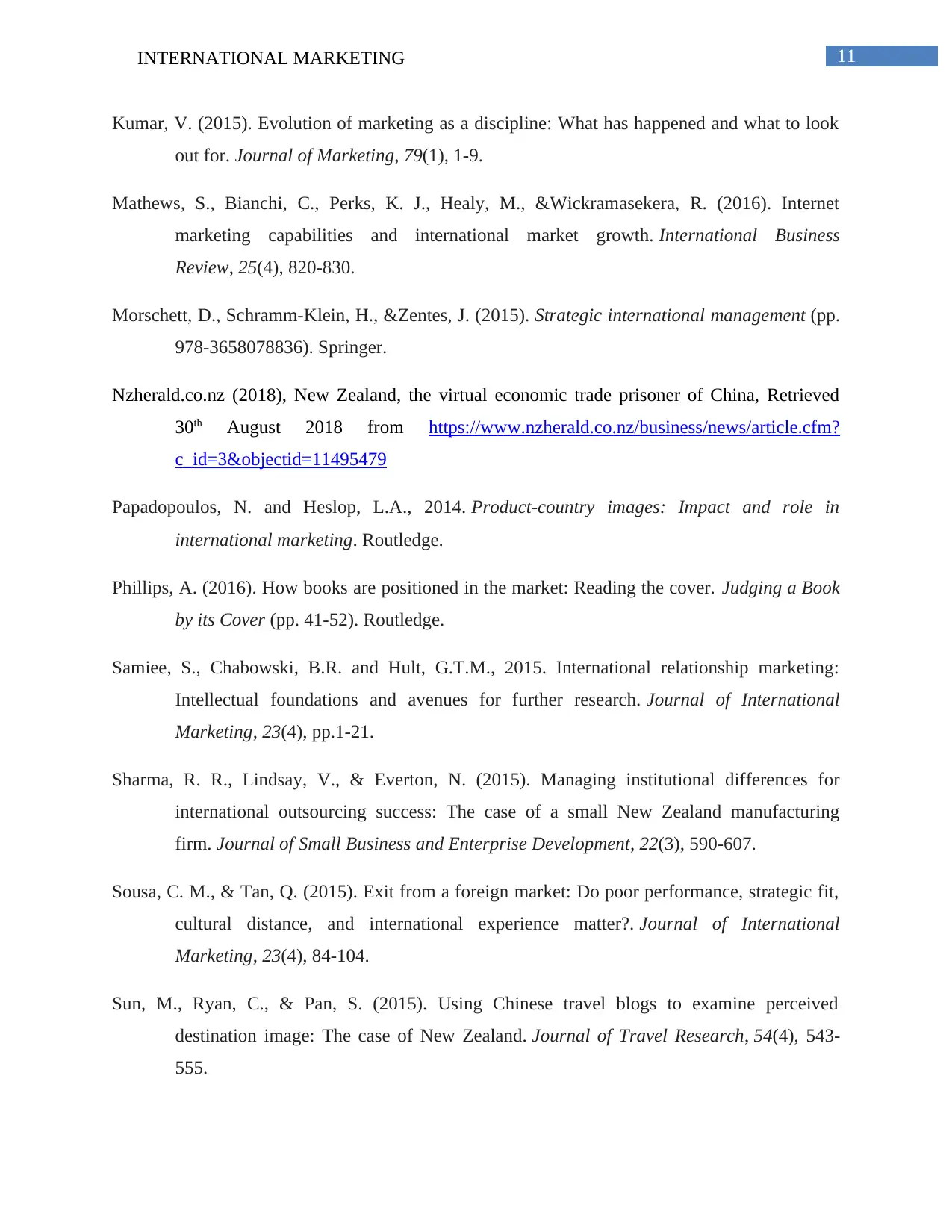
11INTERNATIONAL MARKETING
Kumar, V. (2015). Evolution of marketing as a discipline: What has happened and what to look
out for. Journal of Marketing, 79(1), 1-9.
Mathews, S., Bianchi, C., Perks, K. J., Healy, M., &Wickramasekera, R. (2016). Internet
marketing capabilities and international market growth. International Business
Review, 25(4), 820-830.
Morschett, D., Schramm-Klein, H., &Zentes, J. (2015). Strategic international management (pp.
978-3658078836). Springer.
Nzherald.co.nz (2018), New Zealand, the virtual economic trade prisoner of China, Retrieved
30th August 2018 from https://www.nzherald.co.nz/business/news/article.cfm?
c_id=3&objectid=11495479
Papadopoulos, N. and Heslop, L.A., 2014. Product-country images: Impact and role in
international marketing. Routledge.
Phillips, A. (2016). How books are positioned in the market: Reading the cover. Judging a Book
by its Cover (pp. 41-52). Routledge.
Samiee, S., Chabowski, B.R. and Hult, G.T.M., 2015. International relationship marketing:
Intellectual foundations and avenues for further research. Journal of International
Marketing, 23(4), pp.1-21.
Sharma, R. R., Lindsay, V., & Everton, N. (2015). Managing institutional differences for
international outsourcing success: The case of a small New Zealand manufacturing
firm. Journal of Small Business and Enterprise Development, 22(3), 590-607.
Sousa, C. M., & Tan, Q. (2015). Exit from a foreign market: Do poor performance, strategic fit,
cultural distance, and international experience matter?. Journal of International
Marketing, 23(4), 84-104.
Sun, M., Ryan, C., & Pan, S. (2015). Using Chinese travel blogs to examine perceived
destination image: The case of New Zealand. Journal of Travel Research, 54(4), 543-
555.
Kumar, V. (2015). Evolution of marketing as a discipline: What has happened and what to look
out for. Journal of Marketing, 79(1), 1-9.
Mathews, S., Bianchi, C., Perks, K. J., Healy, M., &Wickramasekera, R. (2016). Internet
marketing capabilities and international market growth. International Business
Review, 25(4), 820-830.
Morschett, D., Schramm-Klein, H., &Zentes, J. (2015). Strategic international management (pp.
978-3658078836). Springer.
Nzherald.co.nz (2018), New Zealand, the virtual economic trade prisoner of China, Retrieved
30th August 2018 from https://www.nzherald.co.nz/business/news/article.cfm?
c_id=3&objectid=11495479
Papadopoulos, N. and Heslop, L.A., 2014. Product-country images: Impact and role in
international marketing. Routledge.
Phillips, A. (2016). How books are positioned in the market: Reading the cover. Judging a Book
by its Cover (pp. 41-52). Routledge.
Samiee, S., Chabowski, B.R. and Hult, G.T.M., 2015. International relationship marketing:
Intellectual foundations and avenues for further research. Journal of International
Marketing, 23(4), pp.1-21.
Sharma, R. R., Lindsay, V., & Everton, N. (2015). Managing institutional differences for
international outsourcing success: The case of a small New Zealand manufacturing
firm. Journal of Small Business and Enterprise Development, 22(3), 590-607.
Sousa, C. M., & Tan, Q. (2015). Exit from a foreign market: Do poor performance, strategic fit,
cultural distance, and international experience matter?. Journal of International
Marketing, 23(4), 84-104.
Sun, M., Ryan, C., & Pan, S. (2015). Using Chinese travel blogs to examine perceived
destination image: The case of New Zealand. Journal of Travel Research, 54(4), 543-
555.

12INTERNATIONAL MARKETING
Tharenou, P. (2015). Chinese international business graduates: A career dilemma: Repatriate or
stay?. Journal of Management & Organization, 21(1), 37-59.
Vellas, F. (2016). The international marketing of travel and tourism: A strategic approach.
Macmillan International Higher Education.
Zhong, J. (2018). Working with Chinese patients: are there conflicts between Chinese culture
and psychoanalysis?. In Psychoanalysis in Asia (pp. 125-135). Routledge.
Tharenou, P. (2015). Chinese international business graduates: A career dilemma: Repatriate or
stay?. Journal of Management & Organization, 21(1), 37-59.
Vellas, F. (2016). The international marketing of travel and tourism: A strategic approach.
Macmillan International Higher Education.
Zhong, J. (2018). Working with Chinese patients: are there conflicts between Chinese culture
and psychoanalysis?. In Psychoanalysis in Asia (pp. 125-135). Routledge.
1 out of 13
Related Documents
Your All-in-One AI-Powered Toolkit for Academic Success.
+13062052269
info@desklib.com
Available 24*7 on WhatsApp / Email
![[object Object]](/_next/static/media/star-bottom.7253800d.svg)
Unlock your academic potential
© 2024 | Zucol Services PVT LTD | All rights reserved.





